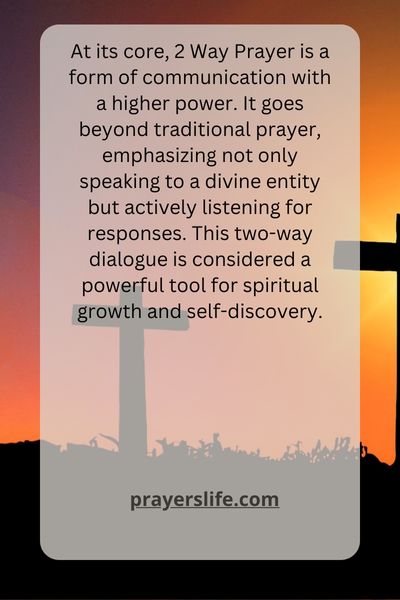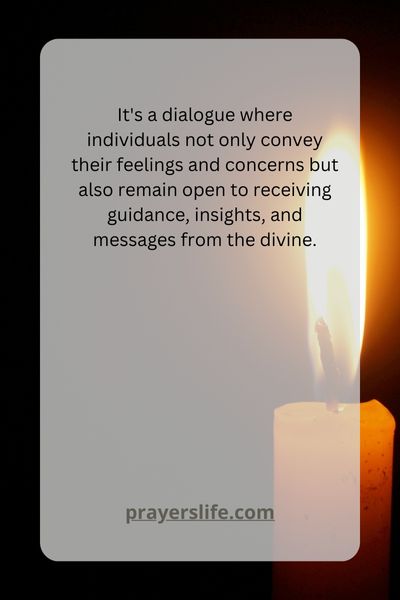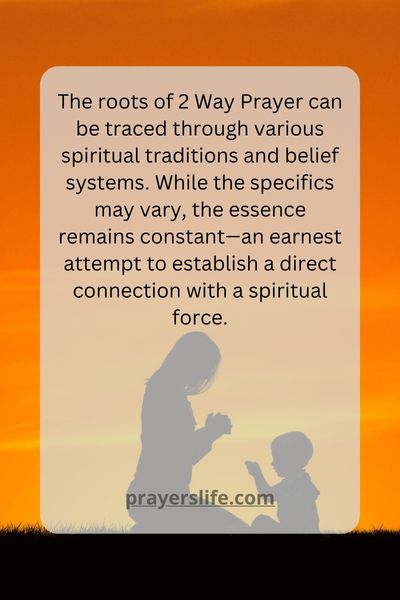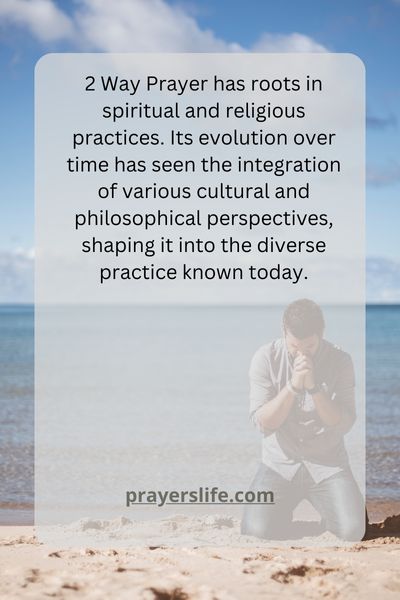Table of Contents Show
Embarking on the exploration of What Is 2 Way Prayer? opens doors to a spiritual realm where communication transcends the ordinary. In this article, we will navigate through the intricacies of this practice, shedding light on its significance, process, and the enriching experiences it offers.
What Is A 2 Way Prayer?
In the realm of spirituality, the concept of a 2 Way Prayer unfolds as a profound and transformative practice, fostering a direct and interactive connection with a higher power. This spiritual dialogue transcends the conventional one-way communication often associated with traditional forms of prayer.
A 2 Way Prayer is a spiritual practice that involves engaging in a two-way communication with a higher power or one’s inner self. Unlike traditional forms of prayer, where individuals typically express their thoughts, desires, or requests to a higher being, 2 Way Prayer extends beyond a monologue. It incorporates a dialogue, creating a reciprocal exchange of thoughts, guidance, and insights.
Understanding the Core Concept
At its core, a 2 Way Prayer is a form of communication with a higher power. It goes beyond traditional prayer, emphasizing not only speaking to a divine entity but actively listening for responses. This two-way dialogue is considered a powerful tool for spiritual growth and self-discovery. The concept of a 2 Way Prayer is rooted in the belief that spiritual communication is a dynamic and interactive process. It is a way for individuals to seek guidance, find meaning, and deepen their connection with a higher power or their inner selves. This practice can take various forms and may be adapted to suit individual beliefs and preferences, making it a flexible and personal journey of spiritual exploration.

The Spiritual Dialogue
It’s a dialogue where individuals not only convey their feelings and concerns but also remain open to receiving guidance, insights, and messages from the divine.

Historical Roots and Evolution
The roots of 2 Way Prayer can be traced through various spiritual traditions and belief systems. While the specifics may vary, the essence remains constant—an earnest attempt to establish a direct connection with a spiritual force. This practice has evolved over centuries, adapting to different cultural contexts and spiritual philosophies, yet maintaining its fundamental purpose of facilitating a genuine exchange between the individual and the divine.

The Origins of 2 Way Prayer
A 2 Way Prayer has roots in spiritual and religious practices. Its evolution over time has seen the integration of various cultural and philosophical perspectives, shaping it into the diverse practice known today.

How It Works
Engaging in 2 Way Prayer involves specific steps, creating a sacred space for meaningful connection. Practitioners often find that establishing a conducive environment enhances the experience, allowing for a more profound connection with the divine.
In this practice, individuals actively listen for responses or intuitive messages during their moments of prayer. The goal is to establish a connection that goes beyond mere words, allowing for a more profound and interactive experience. This form of prayer emphasizes not only the act of speaking but also the importance of being receptive to the messages or guidance received in return.
Personal Experiences
Firsthand accounts of those who have embraced 2 Way Prayer provide valuable insights into the transformative power of this practice. Personal experiences often narrate a sense of connection, solace during challenging times, and a deepening of one’s spiritual journey. These stories serve as testimonials to the authenticity and impact of engaging in a two-way dialogue with the divine.
These varied perspectives offer insights into the potential results and the ways in which people interpret and apply 2 Way Prayer.
Benefits of Engaging in 2 Way Prayer
The practice of a 2 Way Prayer offers a multitude of benefits that extend beyond the spiritual realm. It serves as a conduit for inner peace, clarity of mind, and a heightened sense of purpose. By engaging in this two-way dialogue, individuals often report experiencing a profound sense of guidance, leading to better decision-making and an enhanced overall well-being.
Beyond its spiritual aspects, a 2 Way Prayer is praised for its impact on emotional and mental well-being. Building a deeper connection with a higher power is believed to bring about a sense of peace, purpose, and fulfillment.
The Process Demystified
Engaging in a 2 Way Prayer involves a structured yet personal process. Individuals often create a sacred space, setting aside time for contemplation and meditation. Through focused thought and heartfelt expression, they establish a connection with the divine. The process may include asking questions, seeking guidance, or simply being open to receiving messages through intuitive insights.
Common Misconceptions
As with any practice, 2 Way Prayer is not immune to misconceptions and skepticism. This section aims to debunk myths and address common doubts, fostering a clearer understanding of the practice.
Integrating 2 Way Prayer into Daily Life
Practical tips for making 2 Way Prayer a daily habit are explored in this section. The article offers insights into seamlessly integrating this practice into busy schedules, making it accessible to individuals from all walks of life.
Connection with Mindfulness
Drawing parallels between 2 Way Prayer and mindfulness practices, this section explores the similarities and differences. Understanding how these two concepts intersect can enhance overall mindfulness and spiritual well-being.
Case Studies
Real-life examples of individuals experiencing positive outcomes through 2 Way Prayer are presented in this section. These case studies provide tangible evidence of the practice’s potential to bring about transformation and personal growth.
Criticisms and Controversies
Acknowledging differing perspectives on 2 Way Prayer, this section analyzes criticisms and controversies surrounding the practice. Open dialogue is encouraged, emphasizing the importance of respectful discourse on spiritual matters.
The Role of Faith
Exploring faith-based approaches to 2 Way Prayer, this section considers how different belief systems incorporate this practice. The article emphasizes inclusivity and diversity, highlighting that individuals from various faiths can find value in 2 Way Prayer.
Tools and Resources
For those interested in exploring 2 Way Prayer further, this section provides recommendations for books, apps, workshops, and supportive communities. These resources serve as guides for individuals on their spiritual journey.
Addressing Doubts
Everyone encounters doubts and barriers on their spiritual journey. This section offers insights into overcoming personal obstacles and seeking guidance, encouraging individuals to persist in their exploration of a 2 Way Prayer.
Conclusion
In conclusion, 2 Way Prayer stands as a unique and transformative practice, offering individuals a pathway to deeper spiritual connection and self-discovery. Whether approached with a religious or spiritual lens, the benefits and experiences shared by practitioners highlight the potential for positive transformation.
Frequently Asked Questions
Is 2 Way Prayer a religious practice?
2 Way Prayer has roots in various spiritual and religious traditions, but individuals from diverse backgrounds can engage in it.
How often should one practice 2 Way Prayer?
The frequency of practice varies from person to person. Some find daily practice beneficial, while others engage on a less regular basis.
Can 2 Way Prayer be practiced without a specific belief system?
Yes, 2 Way Prayer is adaptable to different belief systems or can be approached from a more secular perspective.








